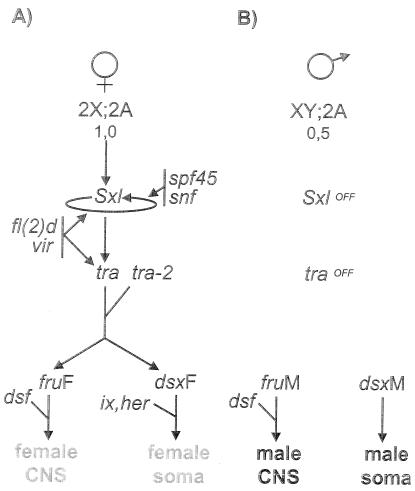FIG. 2.
The somatic sex determination/sexual behavior cascade. A hierarchical interaction exists among the genes that form the backbone of the somatic sex determination/sexual behavior cascade. The product of a gene controls the sex-specific splicing of the pre-mRNA from the downstream gene in the genetic cascade. (A) The ratio between X chromosomes and autosomes (X:A signal) initiates the cascade by activating the expression of the Sxl gene. This activation occurs only in embryos that have the chromosomal constitution 2X;2A. Sxl regulates the splicing of its own pre-mRNA, a positive-feedback loop (8). The products of the fl(2)d, vir, snf, and spf45 genes are also necessary for this splicing regulation (42, 51, 52, 68, 101). The downstream target of Sxl is the tra gene; splicing control by Sxl allows the production of functional protein product (11). Tra forms a heterodimer with the Transformer-2 (Tra-2) protein (2) that modulates the splicing of two genes: double sex (dsx) (18, 56, 58) and fruitless (fru) (49, 60, 93). The generated sex-specific products control the expression of target genes necessary for female sex differentiation and behavior. (B) In X(Y);2A embryos, no Sxl protein is produced. As a consequence, tra RNA follows a different splicing pattern and no functional product is generated. fru and dsx produce male-specific transcripts. FruM and DsxM control the expression of target genes necessary for male sex differentiation and behavior. hermaphrodite (her) (91, 92) and intersex (20) are also required for proper sex differentiation. The dissatisfaction (dsf) gene is implicated in both male and female sexual behavior (31, 32). CNS, central nervous system.

